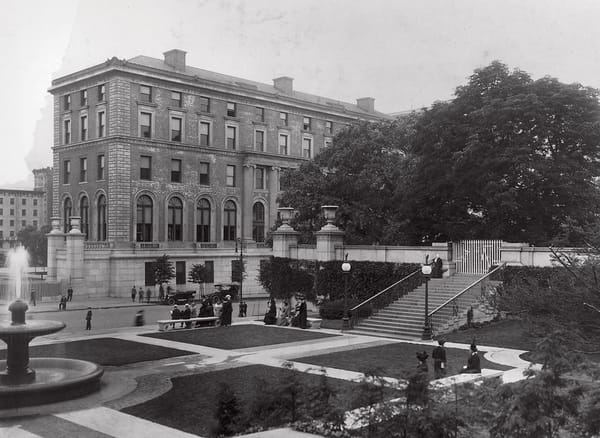Modern Cities as Material Expressions of Power: Interrogating Politics and Design in Paris, Algiers, and Vienna
From towering architectural monuments to the intricate and precise layout of city streets, the spaces humans inhabit profoundly shape behaviour and ways of life.

From towering architectural monuments to the intricate and precise layout of city streets, the spaces humans inhabit profoundly shape behaviour and ways of life. Urban design and architecture conceal many mechanisms of control can shape, direct, and influence human behaviour, serving as a physical manifestation of power. Cities, with dense populations and carefully planned infrastructure, serve as excellent examples of this phenomenon. As hubs of economic, social, and cultural innovation, cities are both centers of opportunity and spaces where large groups can be subtly controlled within confined areas. Modern cities utilize urban design, infrastructural, and architectural principles as a tool for political and social control, to physically shape how people live, move, and interact, highlighting the underlying power structures of society. This essay will first touch on foundational theories of space and power, then focus into three case studies in which various urban design and architectural principles are used as tools for control.
To begin, there are a few key theoretical paradigms to describe the relationship between power and urban space which help to explain the case studies later. The first is that power is relational and spatial, this means that power operates by shaping behavior and limiting freedom through the organization of space. For example, governments manage populations using spatial tools like urban management and zoning to optimize productivity and control. The second principle is the concept of disciplinary spaces, in which institutions such as prisons, schools, and hospitals use spatial designs like surveillance and partitioning to regulate individuals. The use of surveillance, however, is not confined to buildings as these tactics are also used to prevent the creation of resistance spaces, which challenge imposed power structures. Finally, to combat this, the third axis is described by subjectification in which power molds individuals into compliant subjects by influencing how they act within structured spaces (Foucault 1982). These axes serve to emphasize how architecture, infrastructure and urban space is used as political technology and the intersection of architectural design and urban governance.
The first case study that illustrates a modern city as a material expression of power is Haussmann's Paris. The redesign of Paris was commissioned between 1853 and 1870 by Napoleon III with the objectives of modernizing, controlling, and improving public health and aesthetics conditions. Among the Emperor’s proposals the most important for the city’s immediate needs were the completion of the Rue de Rivoli from east to west across the city and the construction of a comparable major through-way through the center of the city from north to south (Pinkney 1958). These long, straight boulevards allowed for a direct shot to attack enemies, while widening them prevented the building of barricades in times of resistance (Pinkney 1958). This shows that while one objective of the boulevard system was to link the streets, another was to create systems for crowd control and surveillance mechanisms. This implies a level of architectural panoptiscism whereby government officials and planners could perpetually observe the masses within the city. Furthermore, to make space available for the elites, entire working-class districts were effaced, along with their architectural landmarks and topographic features. Thousands of residents lost their homes, all in the name of beautification and the great epic of redevelopment (Meyer 2022). This isolation of working-class enclaves in the eastern part of Paris were subjected to ruthless political; containment given their active role during the French Revolution (Meyer 2022). The mass disruption of working class and revolutionary neighborhoods illustrates social engineering through spatial redesign which directly links to the principles of relational and spatial power, disciplinary spaces and subjectification. This connection proves that Haussmann's Paris, a modern city, used urban design principles as a tool for political and social control. The main goal of the redesign can be summarized as a fundamental reconfiguring of urban spatial dynamics to emphasize and materialize social order through sophisticated architectural and infrastructural transformations.
The second example to analyze is Algeria during French colonization from 1830 to 1962 and the transformation of Algiers into a colonial capital. The destruction and reconstruction of the colonial capital echoes’ themes of Haussmann's Paris; but Algiers goes a step further because of its main objective: changing infrastructure to ensure political order through coercive power. Coercive power is a type of formal power that uses the threat of force to gain compliance and submission from those around them. When the French arrived in Algiers, they encountered a winding street network which filtered access to certain passageways. The French saw this system as barbaric, irrational, and inefficient for military movement thus they prioritized cutting through the necessary arteries and streets to enhance geometric coherence, enable rapid maneuvers and appropriate houses, shops, workshops, and religious buildings to lodge their troops (Çelik 1997). The destruction continued with the development of the lower Marine Quarter and the Place du Gouvernement. Noting right away that the existing town lacked a large, conveniently located space for assembling military personnel, the chief army engineers decided to open an immense area in front of the Palace of the Dey. The initial clearing involved the demolition of the minaret of the al-Sayyida Mosque to satisfy the Europeans’ need for wide streets, cartage, and commercial movement (Çelik 1997). The French decided to leave the high casbah untouched to keep the indigenous Algerians separate from the French. This clear radical special segregation of spaces, colonial urban planning, and systematic destruction of indigenous urban infrastructure highlights the extreme architectural and cultural erasure imposed by the French along with the spatial and territorial violence to come. The reconfiguration of the urban fabric and infrastructure of Algiers serves to emphasize that architecture is a manifestation of coercive colonial power, and it can be used as an inherent weapon for colonial governance.
The third and final case study of the relationship between the modern city and the material manifestation of power comes from the rejection of imperial conformity in Vienna during the late 19th century. Vienna was the capital of the Austro-Hungarian Empire at the turn-of-the-century and a cultural hub of modernism due mostly to the Vienna Secession movement of 1897 as a rebellion against traditional art and architecture. This movement towards architectural modernism was crucial in reflecting shifting power dynamics. No building illustrates this theory better than the Purkersdorf Sanatorium whose design embodied the holistic approach to architecture known as gesamtkunstwerk, or “total work of art”. Hoffmann's sanatorium design strategically integrated architectural innovations to address treatment through engineered spatial and technological interventions. The deliberate design of the surfaces, characterized by flat, cleanable materials and crisp geometric edges, facilitated hygiene protocols essential to the institution's therapeutic mission (Imrie and Topp 2009). Large windows and ventilation systems transformed architectural elements into medical technologies, integrating environmental design with contemporary medical understanding of health and disease management (Imrie and Topp 2009). Even still, the Purkersdorf Sanatorium connects to the second axis of spatial and power relationships; disciplinary spaces. A disciplinary space, like power, is not inherently negative. It purely refers to the use of spatial designs such as monitoring and partitioning to regulate individuals, in this case to regulate their health and well-being. These further highlights that aesthetic revolution and social reimagination go hand in hand for the benefit of the people who dwell in those spaces. The relationship between the modernist aesthetic revolution and power comes into play as the Vienna succession movement challenged the traditional roles of power such as those exhibited in Algiers and Paris. In summary, the example of early 19th century Vienna shines light on how architecture can serve as both a medium for functional innovation, the beginning of Sullivans form-follows-function, and as a broader commentary of existing societal power structures.
In conclusion, the analysis of modern cities as material expressions of power underscores the intricate relationship between architecture, urban design, infrastructure and societal control. In analyzing foundational theories of spatial power and the case studies of Haussmann's Paris, colonial Algiers, and turn-of-the-century Vienna, this essay demonstrates how urban spaces are intentionally engineered to shape desired behavior and enforce social order. Haussmann's Paris exemplified the use of urban redesign to control populations and suppress resistance, while colonial Algiers revealed the coercive power of infrastructural erasure and spatial segregation. In contrast, Vienna's embrace of modernist principles highlighted how architecture can provide room for improved social welfare rather than domination. When viewed collectively, these examples corroborate the claim that the spaces humans inhabit influences not only their behavior but also highlights the broader power structures of society. Recognizing these dynamics and relationships allows for a better understanding of the role of design in the shaping of the social fabric of cities.
Bibliography
Çelik, Zeynep. 1997. “The Casbah and the Marine Quarter.” In Urban Forms and Colonial Confrontations: Algiers Under French Rule, by Zeynep Çelik, 11-38. Berkely: University of California Press.
Crow, Thomas. 1994. “Patriotism and Virtue: David to the Young Ingres.” In Nineteenth century art; a critical history , by Stephen Thomas Crow & Eisenman, 22-38. Thames and Hudson.
Foucault, Michel. 1982. “The Subject and Power.” Critical Inquiry 8 (4): 777-795.
Getsy, David. 2010. “Rodin; sex and the making of modern sculpture (Material Evidence, the Gates of Hell and the Making of Rodin).” In Rodin; sex and the making of modern sculpture, by David Getsy, 73-132. Yale University Press.
Henri Lefebvre, Christine Levich. 1987. “The Everyday and Everydayness.” Yale French Studies (Yale University Press) 7-11.
Imrie, Nicola, and Leslie Topp. 2009. “Modernity Follows Madness? Viennese Architecture for Mental Illness and Nervous Disorders.” In Madness and modernity; mental illness and the visual arts in Vienna 1900, by Nicola Imrie and Leslie Topp, 77-99. Farnham: Lund Humphries.
Lampert, Catherine. 1986. Rodin Sculptures and Drawings. The Arts Council of Great Britain.
Meyer, Esther Da Costa. 2022. “Requiem.” In In Dividing Paris: Urban Renewal and Social Inequality, by Esther Da Costa Meyer, 46-94. Princeton University Press.
Meyer, Esther Da Costa. 2022. “The President, the Emperor, and the Prefect.” In In Dividing Paris: Urban Renewal and Social Inequality, 1852–1870, by Esther Da Costa Meyer, 11-45. Princeton University Press.
Pinkney, David H. 1958. Napoleon III and the Rebuilding of Paris. Princeton: Princeton University Press.
Sarabianov, Dmitri. 1990. “Sculpture and Architecture.” In Russian Art , by Dmitri Sarabianov, 94-102. London: Thames and Hudson.
Steinberg, Leo. 1972. “Rodin.” In Other criteria: confrontations with twentieth-century art, 338-371. Oxford University Press.





